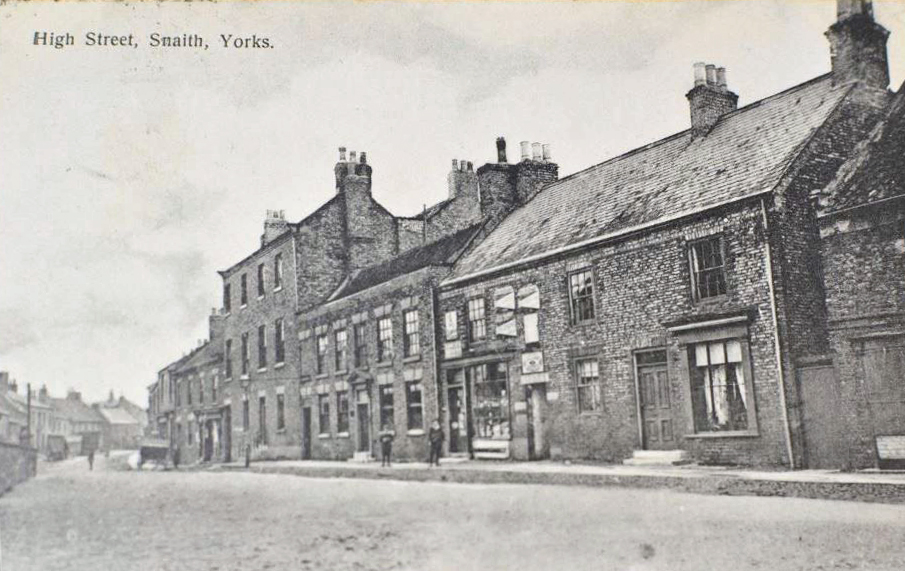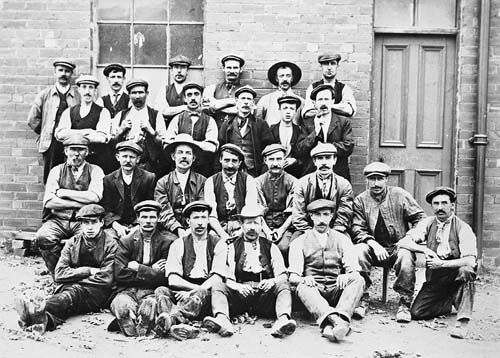Born and Bred
A Yorkshire Family
Ernest Henry Richardson
Ernest's Story
Ernest Henry Richardson, was born into a family of agricultural workers living in Gowdall, a small village in the East Riding of Yorkshire, approximately 1 mile west of the town of Snaith. Not surprisingly the humble "agricultural labourer" is one of the most commonly found occupations recorded on census returns up until the 20th century. Rather than the more specific farm jobs, such as ploughman, farm foreman or dairyman, the agricultural labourer was a man expected to apply himself to any number of manual jobs from ditching and hoeing to helping to bring in the harvest. This was no "rural idyll" but one of the hardest, worst paid and most squalid jobs going.

The 1891 Census of England and Wales records Ernest as living on High Street in Snaith along with his father and mother (Swain and Ann) and his two younger brothers, Swain and Arthur. The house they lived in consisted of four rooms, presumably a traditional two-up two-down arrangement. This type of house was typically a small house with two rooms on the ground floor, usually a kitchen and a living room, and two bedrooms upstairs. Those built before 1875, the pre-regulation terraces, usually shared one outside toilet between several households.
Ernest's four older siblings, Ada, Annie, Frederick and Clara, were no longer living with the rest of the family, but on the date of the census they are recorded as working in the local area.
This then was that life that Ernest was born into and which his family had lived for generations as far back as I've been able to trace, certainly to at least as far back as the mid 1700's. A life of hard and uncertain work with little or no comforts.
In 1891, this was the sort of life Ernest could expect to look forward to. Upon finishing school at 13 he would be expected to get a job as a Farm Servant until he gained enough experience to become a Farm Labourer. He would be expected to marry, raise a family and to continue to work on the land just as his family had done, like so many other families, for countless generations.
However, that was all about to change. Towards the end of the 19th Century Ernest's family, like so many others before them, forsook the land they had lived and worked on for generations, in order to find better paid and more reliable work in the industrialised towns and cities of the county.
By 1901, Ernest, along with most of his family were living at Rothwell in West Yorkshire. Ernest, along with his parents and two younger brothers, were living at 9 Prospect Place, Rothwell. This was a slightly larger house consisting of four rooms, a typical two-up two-down similar to what they had when they lived in Snaith. Now all the men in the family, of working age, were employed in the mining industry that was predominant in the area at that time.
In 1907, for whatever reason, Ernest decided to leave England and travel to America. Whether he had lost his job, or more probably, decided he could make more money, he travelled to the United States. Back then the price of a one way ticket in steerage (3rd class) was £6, that was round about a months wage in the mining industry. The cost of a return ticket in 1st class was £400.
It is fairly safe to assume that Ernest, like so many others, made the crossing to America in steerage. He set sail from Liverpool on the 19th of September 1907 on board the SS Kensington bound for Montreal, Quebec in Canada.
Back in the early 1900s, as the West was finally being tamed, the Chicago, Milwaukee and St. Paul railroad rushed to build a transcontinental rail line to the Pacific Coast. Standing in the way, though, was a formidable peak in the middle of Montana's Bitterroot Mountains.

The rail-road's solution, in 1907, was to recruit thousands of labourers, many of them immigrants, who spent two arduous years boring through hard rock to create a landmark 1.7-mile tunnel connecting the states of Idaho and Montana deep inside the mountain.
We can't know for certain if Ernest was part of this influx of labourers and immigrants, but it seems likely. There are certainly receipts from savings or purchases that put him in Sweet Grass, Montana in the years 1908 and 1909, the time when this particular part of the railroad was being constructed.
This massive undertaking gave birth to a boom town, later named Taft, that a Chicago journalist once called the "wickedest city in America". By the time the tunnel was completed, an estimated 72 people had died from construction accidents, deadly diseases, gunfights and other violence. They were buried in a makeshift cemetery outside town.

No doubt the time Ernest spent living and working there was an interesting one, to say the least and possibly fraught with danger.
Assuming that Ernest had travelled to America to earn more money than he could back home in England, it was more than likely a short term contract. Certainly by 1910 the tunnel and railroad was completed and as previously detailed, the town of Taft had burnt down and its workforce scattered, Ernest was soon homeward bound, travelling sometime around late 1910.
By the time of the 1911 Census of England and Wales he was living once again with his parents and his younger brother Arthur. The family were still living in Rothwell, but had moved to 9 Chapel Street, a small three room house.
Ernest was now working as a "Teamster" at Fanny Pit, one of the many coal mines in the Rothwell area. Fanny Pit was located on Bullough Lane, north of Rothwell Haigh. It was previously known as Midland Pit, but became known as Fanny Pit (named after one of the owner's daughter) after a new shaft was sunk in 1911.

On the 6th of April 1912 Ernest married Alice Tiffany at Holy Trinity Church, Rothwell. Alas, there are very few photographs of either Ernest or Alice, Alice in particular was very reluctant to have her photograph taken.
Ernest moved out of his parent's house shortly after getting married and he and Alice moved into 10 Park View. This was a 3 room house just off Haigh Road, Rothwell. On the 2nd of January 1913 they had their first child, a son they named Frank. On the 13th of March 1919 Ernest and Alice had their second child, this time it was a daughter who they named Ethel.
Ernest's life working in the mining industry and on the railways in America had been a hard one and he didn't want that kind of life for his son Frank. Although they hadn't been able to fund him to go to a better school and really make the most of his maths ability, Ernest wanted him to get a better job, one making full use of his intelligence and skills, one that didn't involve hard manual labour.
When Frank left school at 15, he obtained an apprenticeship at Clayton Son & Co. Ltd, an engineering firm based in Hunslet, Leeds. It was here that he learnt to become a proficient welder.
At the outbreak of the Second World War, Ernest was now 57 and was working as a "Colliery Screen Hand (above ground)", it doesn't indicate what pit he was working at, but most likely he was still at Fanny Pit.
Just before Christmas in 1939, Ernest had promised to get his grandsons, Brian and Kenneth, a Christmas tree in time for Christmas. This he duly did, presumably purchasing it somewhere in Rothwell, he then proceeded to carry it all the way to their house at Sherwood Green in Robin Hood.
He wasn't allowed to get on a bus or tram with it, so he walked just over two miles carrying the tree all the way. Remember, at this time there was a war on, blackout conditions were in effect, so there would be little or no lighting, it was winter and conditions would have been cold and potentially hazardous under foot and this journey was taken at night after he had finished work.
As he reached his grandsons' home, he slipped and injured himself. This resulted in him being admitted to St. James Hospital in Leeds. Sadly, on the 28th of January 1940 he died in hospital. His family always said that the fall led to his death. Whether or not this is true is unknown, the cause of death stated on his death certificate is "Carcinoma of the Stomach". There is no mention of any injuries resulting from a fall.

